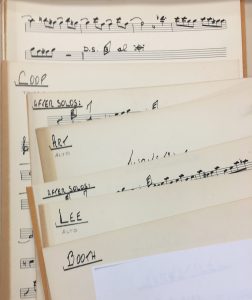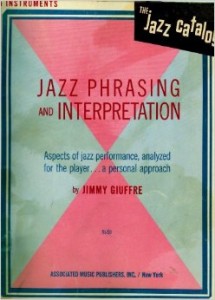I recently had a chance to stop in to the Library of Congress and look for some scores by Jimmy Giuffre. I acquired his pieces for Clarinet and Orchestra and an as yet unrecorded Clarinet and String Quartet piece. While I was there I had a little extra time to dig in to the extensive Gerry Mulligan collection that they have, consisting of over 200 boxes of music and correspondence. I only had time to pick one box, so I saw in the finder’s guide a chart for Venus de Milo, of Birth of the Cool fame, and went with that one. Inside I was excited to find a set of complete parts with the names Lee, Art, Coop, Willis, and Gerry on them, some also said Zoot.
This was for a series of charts for five saxes, the above names referring to Lee Konitz, Art Pepper, Bob Cooper, (Willis) Bill Holman, and Gerry Mulligan. I had never heard of a record by this band so I felt I had discovered something of import, perhaps as yet unheard music. Instead, I discovered that these were the charts for The Gerry Mulligan Songbook released on Pacific Jazz in 1957. Instead of the above named saxists, the recording features Lee, then Zoot Sims on second alto, Allen Eager and Al Cohn on tenors, and Gerry. The charts are great simple blowing affairs by Bill Holman, a couple of which we will perform on October 22nd at the Drawing Room. I bring this up as a lead in to today’s topic, Zoot Sims’ alto playing.
Certainly known more as a tenor player, Zoot Sims plays alto on a few recordings, mostly his own, but this was the first time I had heard him in a section on alto. His solos are a strong substitute for Art Pepper, who was apparently intended for the session, and in fact I would say stylistically the two are quite similar, deriving from Lester Young rather than Charlie Parker. Here is Zoot on track 1 from the Gerry Mulligan Songbook, “Four and One Moore.”
[audio: http://www.jondelucia.com/wp-content/uploads/2016/09/zootfour.mp3]
Paul Desmond always claimed Zoot as one of his favorite players, and one can hear some similarities in feel and vibrato, while also being generally more propulsive than most of Paul’s playing.
Zoot also made a couple of novelty albums with new overdubbing technology, namely Zoot Sims Plays Four Altos, with arrangements by George Handy. You can hear a bit on Amazon here: https://www.amazon.com/Plays-Tenor-Altos-Zoot-Sims/dp/B000QTD52K.
Bassist Bill Crow told me that when they recorded this, Zoot improvised on one alto, then gave the recording to George Handy, who transcribed it and voiced it for 4 altos. When he brought the arrangements in for Zoot to record, he had voiced every single note, creating some tricky lines. Zoot complained that he wouldn’t be able to play it, so George simplified the parts a bit. The result is this unusual record, but it does feature some great alto playing by Zoot.
One can find examples scattered throughout the 50’s before Zoot focused on the tenor, and occasionally soprano. Here is one I just discovered today, another overdubbing experiment:
I love this particularly Lesterian lineage of alto players, that also includes people like Bud Shank, who’s live at the Haig recording especially swings, and of course Art Pepper, and in a way Benny Carter and Cannonball Adderley, alto players that are really descended from the swing era.. I’ll talk more about lineage in next week’s post, but I encourage you to check out more Zoot Sims on alto. And please do share any others I don’t know about in the comments!


